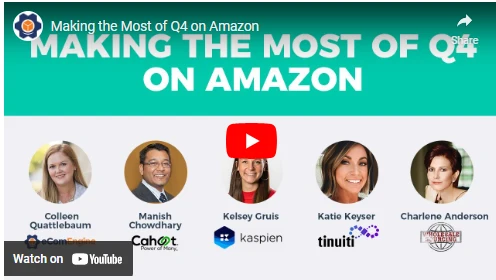Amazon Q4 Playbook – Expert Tips on Maximizing Sales & Profits

How to Make the Most of Amazon Q4 2021
At over $100B, Q4 2020 was by far the biggest in Amazon history. Unsurprisingly, Q4 2021 is expected to set yet another new record.
This year brings unprecedented opportunities but also new challenges and greater uncertainty. New FBA inventory restrictions, supply chain challenges, and higher CPCs all threaten sellers’ ability to capture record-setting growth. If you haven’t already, now is the time to start preparations to make the most of Amazon Q4.
Watch the on-demand webinar or read on to get the Q4 profit-maximizing advice you need from veteran Amazon 3P seller Charlene Anderson, Cahoot CEO Manish Chowdhary, and a panel of other leading Amazon experts from eComEngine, Kaspien, Tinuiti, Cahoot, and Wholesale Sourcing.
Keep reading to learn how to make the most out of your Q4:
- How to Optimize Amazon Advertising Spend in Q4 2021
- How FBA Sellers Can Grow Their Q4 Amazon Sales Despite Inventory Limits
- The Best Way to Manage FBA Inventory with the New Storage-Type Limits
- How Sellers Can Improve Their Inventory Performance Index (IPI Score) in Q4
- How FBA Sellers Can Get All the Reimbursements They Deserve
- When Amazon Sellers Should Ask for Ratings and Reviews in Q4 2021
- Strengthen Supplier Relationships Year-Round for Q4 Preparedness
How to Optimize Amazon Advertising Spend in Q4 2021
“I would highly recommend considering getting active on the DSP platform. It allows you to promote on and off Amazon, and it also allows you to showcase the products that are in stock.”

Katie Keyser
Marketplace Specialist at Tinuiti
Increased competition has made efficient advertising harder to find on Amazon. Still, creative sellers can keep their Cost-per-Click (CPC) low and their conversion high in Q4 with innovative ad techniques.
Amazon Ad Cost Per Click (CPC) is Rising Quickly
Cost-per-Click has exploded across all formats in competitive product categories. Tinuiti’s Amazon Ads Benchmark Report: Q2 2021 reveals that the average Amazon CPC for sponsored products rose 33% YoY just in Q2 – the highest cost growth observed in years. Every type of advertising saw a cost increase – CPC soared 46% for Sponsored Display, 19% for Sponsored Products, and 4% for Sponsored Brands. This growth shows no signs of slowing down, so read on for tips on how to make the most of your advertising
Start and Stop Earlier Than You Think
The first significant change to Amazon advertising is timing – the days of getting great returns on just-in-time ads are long gone. In 2020, we saw something curious; advertising spend peaks started and ended much earlier than they did in 2019. Social distancing guidelines changed holiday shopping from multiple trips to the mall to ordering on Amazon from home. Unfortunately, much more gift-giving happened via parcel than in person. Shoppers heard the news of the supply chain crisis, so to make sure their gifts arrived on time, they bought earlier than they had in the past. On top of that, many gift-givers were dismayed to see their gifts arrive late due to the massive capacity crunch, so they’re planning on shopping even earlier this year.
Since customers moved up their shopping period, smart sellers will move their advertising clicks and resulting sales earlier. Even last year, many sellers found that the value of advertising clicks diminished the most in the days leading up to Christmas. With the rise of the Delta variant, supply chains still in disarray, and carriers unable to keep up with demand, early shopping is sure to repeat this holiday season. Make sure that you’re advertising when people are shopping, and don’t miss the boat.
Try New Formats Like Sponsored Brand Video Ads, Sponsored Display Ads & Amazon DSP
New ad types can help sellers stand out amongst the competition. “Out of all of the newer ad types that have become available, leveraging Sponsored Brand Video ads, Sponsored Display ads, Amazon DSP, and promotions and coupons are going to be your best bet this year,” according to Katie Keyser, Marketplace Specialist of Tinuiti.
Sponsored Brand Videos accounted for 30% of all Sponsored Brands spend in Q2 ‘21. Video is ideal for products that benefit from more consumer education, where buyers need to see how a product works before pressing “Add to Cart”. Leveraging video is a great way to showcase how a product can help improve someone’s life. On top of improved click rates, conversion rates tend to be higher for products with video ads once they get to the product detail page. In addition, Amazon recently came out with a targeting tactic that enables advertisers to leverage Sponsor Brand Videos on the product detail pages of competitors, relevant products, or complementary products. Use this to gain a competitive edge and grab share from your top competitors.
Another effective but underutilized ad format is the Sponsored Display ad. Use these to target specific audiences to build awareness and consideration. Sponsored Display is also a great way to retarget shoppers that have been to a product detail page, but have not yet purchased. Use these to build your audience and to re-engage shoppers already familiar with a brand’s products from past Prime Day, Black Friday, and Cyber Monday campaigns.
Ad spend on Amazon DSP (Demand-side Platform) doubled YoY in Q2 of ‘21, and for a good reason. Amazon DSP enables advertisers to programmatically buy display, video, and audio ads both on and off Amazon, boosting reach. Advertisers can target customers contextually across different devices and channels including Amazon sites, Amazon mobile apps, FireTV, and IMDb. Amazon DSP also offers a lot of flexibility; it can serve up ads depending on inventory availability. This makes it an excellent option for advertising only products in stock or those that have recently launched and need as many eyes as possible in a short timeframe.
On top of new formats, tie promotions and coupons into your ads to give them an edge over the competition. Your products will stand out against others and you’ll have an extra competitive edge in this most critical time of year. Coupons display in SERP results and showcase on various ad types like Sponsored Brand ads, Sponsored Display ads, and DSP ads. Promotions and coupons can be an eye-catching way to entice consumers, capture their attention, and let them know that there is a discount on that product.
Sellers Must Optimize Listings to Convert Better
Amazon Advertising can do wonders in driving impressions to your listings, but it will all be a waste if you don’t have competitive pricing and free and fast shipping.
Savvy sellers monitor their listings’ price daily or even hourly; make sure that you’re keeping a close eye on how you compare to similar products.
On and off Amazon, consumers have come to expect free and fast delivery. To make sure that your ad dollars are well spent, offer free and fast shipping on your FBM listings as well as your FBA and SFP listings. Back-up FBM listings with slow shipping simply won’t cut in in the holiday season when consumers expect delays, and so won’t trust that your product will reach their recipient in time.
How FBA Sellers Can Grow Their Q4 Amazon Sales Despite Inventory Limits
“Amazon sellers are dealing with a massive amount of challenges and uncertainty this year. In addition to carefully managing their IPI score, they should leverage FBM with distributed fulfillment to avoid stockouts when FBA won’t take their inventory.”

Manish Chowdhary
Founder and CEO of Cahoot
FBA is a great solution for shipping small packages sold on Amazon – when you can get it. In April 2021, Amazon changed their inventory limits for FBA, reducing merchants’ inventory space by as much as 60%. Sellers are still scrambling for back-up plans to ensure that their listings won’t go out of stock in Q4 and beyond, stunting growth.
It’s not easy, but it’s also not as hard as it looks. Here’s what Cahoot recommends.
Create FBM Listings as Backups for FBA Listings to Avoid Stockouts
If not already in place, FBA sellers should set up FBM and create backup listings for their FBA ASINs. This helps avoid stockouts and the subsequent death spiral of diminishing search rank and inventory limits. FBM also facilitates the launch of new products and makes up for low storage-type limits for seasonal sellers.
FBA sellers that don’t have warehouses of their own should outsource fulfillment to an FBA Alternative that offers nationwide 1-day and 2-day delivery. Without fast and cost-effective shipping, sellers will find their FBM back-up listings uncompetitive and unprofitable.
Furthermore, the best USA fulfillment center networks work just as well for other marketplaces and ecommerce sites as they do for Amazon. Using FBA for multi-channel fulfillment can be almost 3x as expensive as FBA, so if you want to grow with a multi-channel strategy, you’ll need another option. FBM is easier than it seems when you work with a top partner, and it unlocks growth on other channels as well.
Ramp Up Amazon Seller Fulfilled Prime (SFP)
With Amazon reluctant to approve new applications for SFP, those that have it should maximize their competitive edge while it lasts. SFP provides all of the Buy Box and sales benefits of Amazon FBA without any of the IPI concerns or FBA storage-type limits.
Many sellers that had regional SFP have struggled to keep up with new nationwide SFP requirements, and as a result they’ve had to shut down the program entirely. Unfortunately, many have lost revenue as a result. They can regain that competitive edge, though, with a fulfillment partner like Cahoot that offers Amazon SFP Fulfillment Services.
Offer Free & Fast Shipping on Your Shopify, BigCommerce, or Magento Store
Many Amazon sellers also have websites, but they don’t offer the same free and fast delivery offered on Amazon. That’s a shame – website sales don’t incur Amazon’s 15% referral fee or all the other costs and hassles associated with FBA, but they can’t win without free and fast shipping. Every seller would prefer to see the Q4 surge happen on their own website instead of Amazon, but for now that’s a pipe dream.
Some sellers, though, aren’t accepting Amazon’s dominance. They’re beating Amazon at their own game by offering their best price and free and fast shipping on their website. Every customer that buys on a website instead of Amazon is 15% more margin for the seller – what a deal!
To learn how distributed fulfillment makes it easy and affordable to offer nationwide free and fast shipping on brand websites, check out the on-demand webinar: Your Website vs. Amazon – How To Complete & Win with Free & Fast Shipping.
Reduce Seasonal Labor Costs with Next-Gen Shipping Software
Many FBM sellers are dreading the upcoming Shippagedon. Seasonal labor will be in short supply and more expensive than ever this year. Maximizing same-day fulfillment is crucial, but with traditional shipping software like ShipStation, it can take hours each day to rate shop and route orders – even with complex shipping rules in place.
FBM sellers should switch to next-generation shipping software that offers automatic routing, rate shopping, and the cheapest label generation. With a ShipStation alternative, all shipping labels are ready before the warehouse staff arrives, so they can start picking orders first thing in the morning. FBM sellers can easily extend their same-day shipping cutoff time to much later in the day. As a result, merchants significantly increase same-day fulfillment capacity while reducing fulfillment labor costs by as much as 40%.
The Best Way to Manage FBA Inventory with the New Storage-Type Limits
Demand for FBA far outstrips Amazon’s ability to add capacity. To manage overall FBA storage capacity against sales volume, FBA constantly changes quantity limits, and this year is no exception. The upshot is that few (if any) merchants place all the inventory they’d like in FBA.
In April of ‘21, FBA announced the change from ASIN-level limits to storage-type limits. Under the new restriction, sellers’ items fall into six storage-type categories: Standard, Oversize, Footwear, Apparel, Flammable, or Aerosol. As a result, most sellers have found that their overall inventory levels were slashed by as much as 20-65% – a big challenge heading into a record-setting Q4 on Amazon.
Merchants don’t have to be limited by FBA’s ever-narrowing restrictions: here’s what you’ll need to do to protect your growth.
1. Send Smaller, More Frequent Restock Orders to FBA
While FBA positioned their April change as offering “more flexibility in managing your shipments,” the reality is that sellers have much greater complexity in managing shipments. Under the new restriction, most sellers can no longer send full container loads to FBA.
Instead of sending full containers to FBA, sellers will need to become adept at breaking up their inventory into smaller shipments and sending frequent restock orders. The limits are so low that many sellers must now send restock orders as frequently as daily, increasing shipping costs and overhead. Unfortunately, this is the new reality of working with FBA.
2. Leverage Fulfillment by Merchant (FBM) for Seasonal Sellers
FBA’s advice for addressing seasonal fluctuation in sell-through rates is for sellers to add counter-seasonal SKUs to their catalog to keep their sell-through rates and storage-type limits high enough to handle the peak season. On paper, it can work, but Amazon’s sweaters and swimsuits strategy seems impractical at best.
A more feasible and cost-effective approach is to set up alternative fulfillment that enables merchants to sell beyond their FBA limits. One such option is to use a peer-to-peer fulfillment network that offers fast nationwide shipping on FBM listings so that sellers can maximize conversions during their most significant and most critical selling season.
3. Only Launch New Products if They Are Sure Winners
Since the old inventory limit of 200 units for new ASINs is no longer in effect, sellers can now send as many units for new ASINs as they wish – so long as they remain under their overall storage-type limit. This sounds great, but there’s a trap: these new ASINs consume the same limited space as existing top sellers, so launching them in Q4 will crowd out hero SKUs.
Cahoot recommends two strategies for launching new products on Amazon:
- Launch New ASINs Outside of Q4
Launch new products outside of Q4, when managing IPI scores is typically less critical.
- Create Backup FBM Listings to Avoid Stockouts
Create both FBA and FBM listings for new ASINs. Using FBM eliminates any potential hit to IPI scores from new ASINs that turn out to be slow-moving. Offering new ASINs via FBM also provides a lot of flexibility to respond to demand spikes or avoid stockouts.
4. Watch Out for Key Amazon Shipping Deadlines
At this time, Amazon hasn’t published their 2021 shipping deadlines. They may very well be earlier than 2020’s already early cutoffs, and they are unlikely to be later. Sellers need to carefully plan their inbound orders and FBA shipments around critical dates such as Black Friday, Cyber Monday, holiday sales, and initial 2022 restocking.
FBA Holiday Inbound Dates (last year)
- Black Friday & Cyber Monday – latest arrival at FC is Nov 6, 2020
- Christmas – latest arrival at FC is Dec 1, 2020
- 2021 – earliest arrival at FC is Dec 17, 2020
2022 Inventory Inbounds After Mid Dec Only
- Sellers can’t ship 2022 inventory before mid-December (predicted)
- Sellers need to park their 2022 inventory at a 3PL until it’s allowed by FBA
How Sellers Can Improve Their Inventory Performance Index (IPI Score) in Q4
The FBA Inventory Performance Index, or IPI Score, measures how efficiently and productively Amazon sellers manage their FBA inventory.
“Amazon FBA acts like a river. Amazon wants your products to be flowing in on one side and flowing out on the other. As soon as you ship them in, Amazon wants them to be shipping out. So there’s this constant movement of product. They don’t want to get three months’ worth of product, and they want products constantly moving in and out.”

Charlene Anderson
Founder of Wholesale Sourcing Experts
Sellers who do an excellent job are rewarded with higher IPI scores and ultimately higher storage-type limits. Conversely, sellers that don’t are penalized.
Your IPI score is determined by four factors:
- Excess inventory
- Sell-through rates
- Stranded inventory
- In-stock inventory
Amazon hasn’t published the exact algorithm, but the better sellers do with these individual metrics, the higher their IPI scores. The higher the IPI score, the higher storage-type limits become. And of course, inversely, the lower the IPI score, the lower the storage-type limits. For a deep dive into managing IPI scores, check out the on-demand webinar; How to Improve Your IPI Score & Maximize Amazon Sales. In the meantime, here are some Q4 tips.
1. Reduce Excess FBA Inventory
Between the impact of storage-type restrictions and slow-moving SKUs, storing excess inventory at FBA is a luxury no one can afford. Sellers should create disposal or return orders for excess inventory immediately. Once such orders are submitted, the excess inventory no longer impacts sellers’ IPI scores; sellers do, however, continue to incur storage fees up to the point of physical removal.
Another option is to switch excess inventory listings from FBA to Amazon Multichannel Fulfillment (MCF) and offer them through additional sales channels. Unfortunately, Amazon charges much more for fulfilling non-Amazon orders than they do for FBA, so margins decline as sell-through rates and IPI scores improve.
2. Improve FBA Sell-Through Rates
Improving sell-through rate is the most significant factor in determining IPI scores, and on top of that, it’s great for business. It’s equal to the Total Sales of each ASIN divided by the Average Inventory Level of each ASIN for the last 90 days. Here’s a few ways to improve Amazon sell-through rates:
- Optimize Amazon FBA Listings for Impressions & ConversionGreat reviews and A+ content are some of the best ways to increase visibility and conversion. For a comprehensive strategy on optimizing listings on Amazon and other marketplaces like Walmart and eBay, check out this on-demand webinar; How to Optimize Listings for Maximum Impressions and Conversion.
- Drive Visibility Through Ad Spend and PromotionsConsider boosting the visibility of listings with Amazon Advertising and driving more conversions with offers like free shipping and BOGO. Of course, it is vital to consider the impact of advertising on margins. Big ad spends without compelling offers can be a waste of money, but well-executed campaigns can pay off.
- Add More Fast-Moving SKUsWhile this is easier said than done, adding more fast-moving SKUs is a straightforward way to boost IPI scores.
3. Fix Issues with Stranded FBA Inventory
There are several ways that FBA inventory can become stranded. Occasionally inventory in FBA gets inadvertently listed as FBM and thus gets stranded. Sometimes it’s a situation where the listing itself has been closed. It is also possible that pricing triggers an alert, and Amazon shuts down the listing to prevent it from selling outside of the minimum or maximum selling price set by the merchant.
The first step should always be to relist or fix stranded listings. Amazon’s automation tool can sometimes help with this. If the seller cannot fix the listing, the next step is to remove the inventory, which also helps with the excess inventory metric.
4. Avoid FBA Stockouts
In light of the new FBA storage-type restrictions, FBA’s delays with receiving goods in Q4, and the broader global supply chain crisis, stockouts are rightly among the biggest concerns for online retailers everywhere. Stockouts can kill IPI scores and put visibility and product sales into a death spiral.
To avoid stockouts, Amazon sellers should create backup FBM listings for all of their top-selling FBA ASINs and when FBA stock is running low, use in-house fulfillment or an FBA Alternative to fulfill those orders.
How FBA Sellers Can Get All the Reimbursements They Deserve
“Amazon makes mistakes. They’re humans, too. Amazon added nearly a million new sellers last year alone, so there’s a lot of room for error. And that’s exactly what happens and why Amazon owes us money.”

Kelsey Gruis
VP of Business Development at Kaspien
The vast majority of Amazon sellers use Fulfilment by Amazon (FBA), and they spend tens if not hundreds of thousands of dollars each year on FBA services such as receiving, storage, and fulfillment. It’s safe to say that Amazon has a lot going on, and of course they make many mistakes.
The mistakes aren’t going to slow down any time soon – after all, Amazon introduced nearly a million new sellers in 2020. With FBA, there will always be situations where Amazon mishandles inventory, overcharges for fulfillment and storage fees, and under-reimburses sellers. Kelsey Gruis, VP of Business Development at Kaspien, stresses this point by saying, “Long story short: If you’re utilizing FBA, Amazon most likely owes you some money for the inventory they’ve mishandled, overcharged, or damaged, and they will not automatically refund you for all that you are owed.”
There are many scenarios in which sellers find themselves under-reimbursed. According to Kaspien, discrepancies in the receiving quantity of inbound shipments can make up as much as 90% of the reimbursement shortfalls. Others include:
- Inbound orders arrive damaged
- Merchandise at FBA that becomes lost or damaged
- Items lost or damaged during removal
- Missing customer returns
- Incorrect amounts refunded to customers
- Past overcharges
- Orders refunded but not returned by customers
Sellers that want to maximize profits need to audit reimbursement statements vs. actual shipments, damage reports, storage, and fulfillment statements to identify discrepancies between money owed and money credited. Next, sellers must file and follow up on inventory reconciliation cases on Amazon Seller Central. This must be a constant, year-round effort to capture as much of the reimbursements due as possible.
These processes require copious amounts of manual manipulation to create and follow-up on cases. It takes a lot of man hours, and more than that, it’s easy for manual reviewers to miss claims or to let claims expire. Many sellers turn to seller reimbursement software like Kaspien’s Channel Auditor to lighten the load and protect their time and sanity.
This kind of software connects directly to the Amazon Seller Central account and automatically cross-references across up to 17 different reports. Such software can identify Amazon reimbursement case opportunities going back up to 18 months. The software can even provide the exact text needed to create the case, including links to evidence supporting the claim. Channel Auditor then automatically tracks case progress and results, and if Amazon under-reimburses a seller, the software alerts them to act. In short, it’s an automated solution to get sellers what they deserve from Amazon.
When Amazon Sellers Should Ask for Ratings and Reviews
in Q4 2021 “From mid-November on, I would recommend adjusting the timing of your review request to be 30 days after delivery. People are more motivated to leave a review after that Christmas holiday when they’ve received the gifts.”

Colleen Quattlebaum
Marketing Manager at eComEngine
It’s simple: consumers trust customer ratings and reviews, so driving great reviews from Q4 sales has a lasting positive impact on conversion rates and sales throughout the following year. They’re the best tool for making sure that Q4 isn’t just a one-off success, and instead the start of something great.
An obvious but sometimes overlooked factor in driving more reviews is asking for them. With the click of a button, tools like eComEngine’s FeedbackFive automatically send email requests to the customer. Formatting and links make it easy for recipients to easily leave a review from the convenience of their mobile device, tablet, or desktop.
With reviews, timing is everything. Throughout the rest of the year, the best practice is to ask for a review within a few days of an item being delivered, right when the customer has fallen in love with the cool new thing they just bought. However, the timing for driving reviews in Q4 is much different due to the obvious factor: everyone waits to open their gifts until the holiday itself.
Colleen Quattlebaum, Marketing Manager at eComEngine, offers this advice, “While I typically recommend sending a product review request a few days after that order delivery, when it comes to mid-November and beyond, I would recommend adjusting the timing of your review request to be 30 days after delivery”.
This way, the buyer will receive the request at the end of December, when they are most likely to leave a review due to the recipient recently receiving and falling in love with their gift.
Strengthen Supplier Relationships Year-Round for Q4
“Right now, you really need to cement those relationships you built with your suppliers, give them a call, send them an email, send them a text and just check in… I like to say that you always have to be sourcing… Things can change, businesses can close, new businesses open up, new products come out year-round.”

Charlene Anderson
Founder of Wholesale Sourcing Experts
When suppliers are low on stock, who gets the shipment? The statistic on a spreadsheet that never says hello, or the seller who has fostered a real relationship for years? Sellers shouldn’t be just one of the many companies that order from a particular supplier once every few weeks; they should develop year-round personal relationships that keep their company and their orders top-of-mind of crucial suppliers.
Charlene Anderson, 20 year Amazon veteran and Founder of Wholesale Sourcing Experts, relates how this can pay off: “That’s happened with me – containers have come in, and my people at one of my biggest suppliers have said, we’re going to give it to you, even though you’re second on the list”.
A Plan B is important too, of course. Sellers should always be on the lookout for alternative suppliers of existing products to make sure that when one deal falls through, another takes its place. This has always been a solid business practice, but global supply chain disruptions and courier delays have made it an absolute necessity in 2021 and beyond.
Summary
2021 will be a record-breaker for Amazon, and it can be for sellers too – if they start preparing now and manage their suppliers, fulfillment, advertising, reimbursements, and reviews well throughout Q4. There’s no easy answer to all of this complexity, but those that stay on top of their game will reap the rewards this year and beyond.
